Day 2 of a three day Early Autumn Tour today. After a cloudy start, it brightened up and was then nice and sunny until it clouded over again later in the day. We spent the day today exploring the North Norfolk coast.
As we made our way east along the coast road, we spotted a Barn Owl quartering over some wet grazing marshes. There had been some rain overnight, so perhaps it had struggled to hunt and was therefore still out this morning. We managed to pull up and watch it for a few minutes as it worked its way round and round over the grass. A great start to the day.

Our first destination for the morning was Stiffkey Fen. As we got out of the car, a grey-winged male Marsh Harrier flew in across the field next to us. We had a good view of it, before it disappeared round behind the trees.
Some birds were feeding in the tramlines through the stubble. As well as a couple of Pheasants, there were four Stock Doves. We had a good look at them through the scope, noting their glossy green neck patches and black spots on the wings. When the Marsh Harrier returned, the Stock Doves took off and we could see the neat blackish trailing edge to their wings and the lack of any white wing stripe.
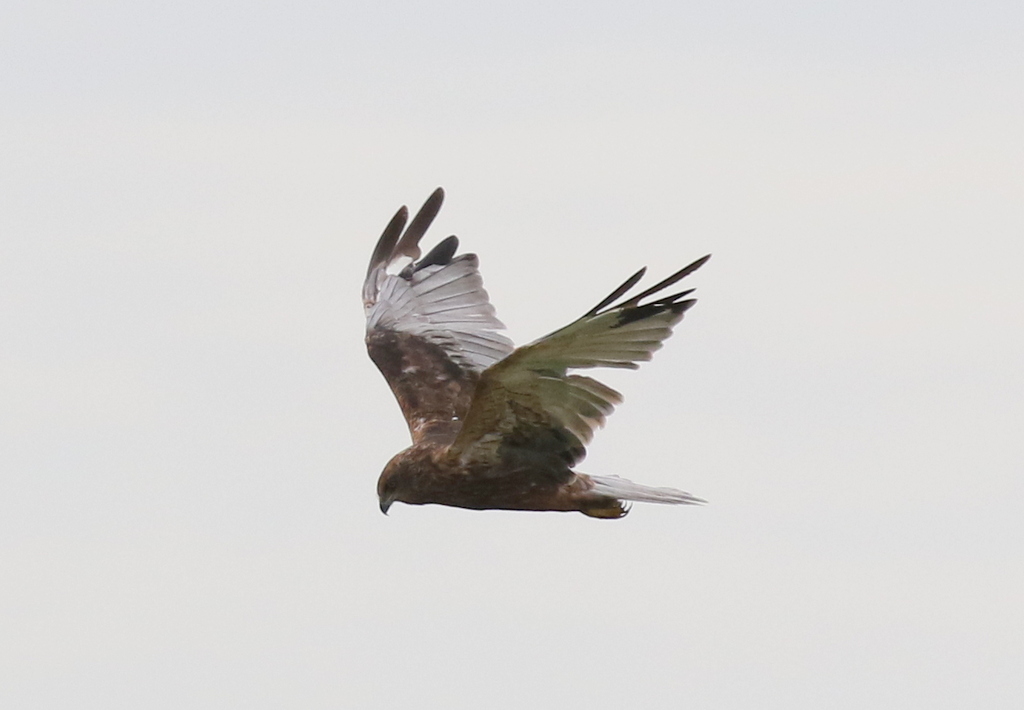
There were two Brown Hares in the field opposite. We could hear a Kestrel alarm calling and a Common Buzzard mewing, but it was still probably a bit too early and too cool for the latter to be up circling above the trees.
Along the footpath beside the river, we found the big tit flock again but the birds were keeping hidden in the trees this morning. We could see several Long-tailed Tits and we heard one or two Chiffchaffs. A male Blackcap appeared on the outside of a bush eating blackberries. While we were watching the flock, three Bullfinches flew in calling and landed in the trees with them, before disappeared off in the other direction along the river bank.
There is a point along the path here where you can see over the brambles to the Fen beyond. When we got there, we were immediately struck by a long line of white birds asleep on one of the islands. A very large group of Spoonbills, doing what they like to do best!
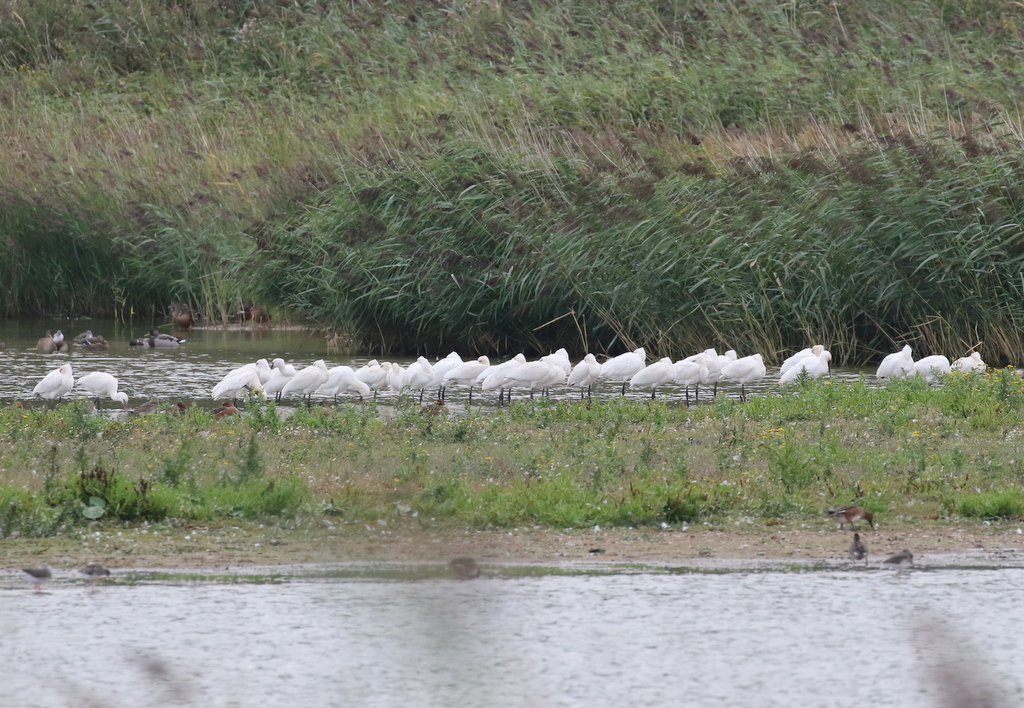
There were some waders visible from here too. Eight Greenshanks were tucked up along the edge of the reeds at the back, along with a couple of Green Sandpipers. There were more waders hidden from our view behind the reeds at the front, but while we stood here more flew in to join them, presumably coming in from the harbour as the tide rose. There were flocks of Ruff and Black-tailed Godwits dropping in, and a single Bar-tailed Godwit too.
From up on the seawall, we had a better view of the Spoonbills. Some even woke up briefly and flashed their spoon-shaped bills. One adult on the edge of the flock was pursued remorselessly by a juvenile begging to be fed, bouncing its head up and down and flapping its wings. Through the scope, we could count them properly too – the grand total of 36 Spoonbills here today. Quite an impressive sight!
We could see all the waders roosting out in the water in the middle from here too. As well as all the Black-tailed Godwits and Ruff, there were good numbers of Common Redshank. Looking closely, we found a single Spotted Redshank with them too, noticeably paler grey above, whiter below, and with a more noticeable pale supercilium just visible, despite the fact it was asleep with its bill tucked in.
There are lots of ducks on here now, as birds have returned for the winter. Wigeon, Gadwall, Teal and one or two Shoveler. In the water, busy upending, were ten Pintail. There are always plenty of Greylags here, with more dropping in from the fields beyond all the time. Small groups of Pink-footed Geese were flying west overhead all morning, birds returning from Iceland, coming here for the winter.
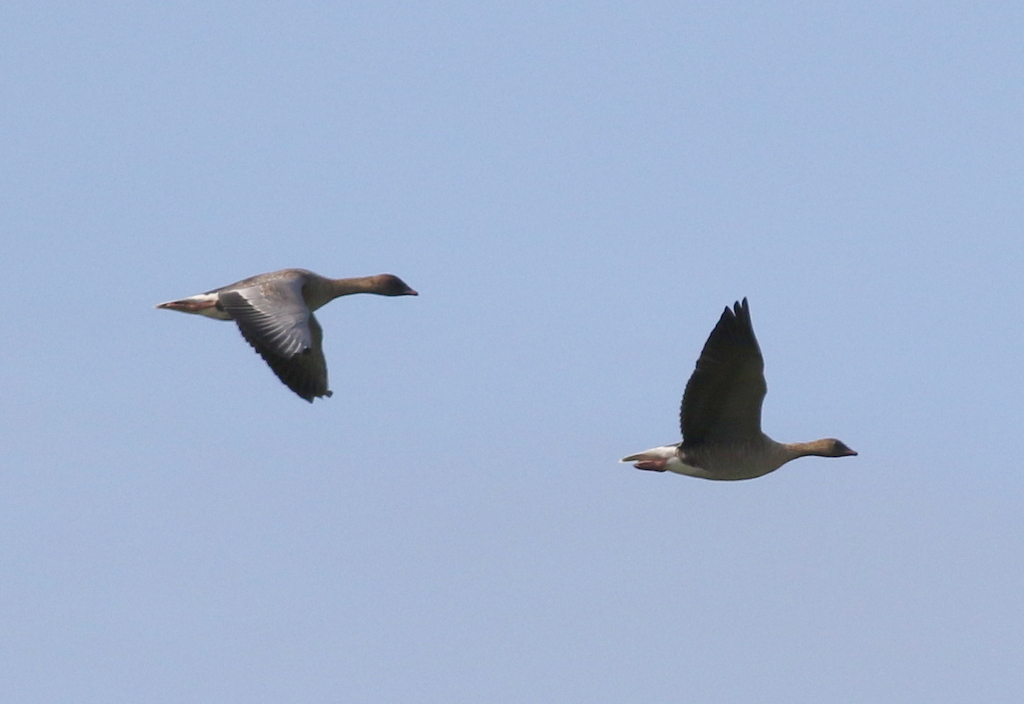
Looking out across the harbour from the seawall, we could see lots of seals hauled out on the tip of Blakeney Point. Several Sandwich Terns were fishing out in the pit and beyond, in the distance, we could see two dark juvenile Gannets plunge diving in the sea the off the Point.
We picked up a falcon flying in fast and low across the harbour and when it turned and climbed towards the Fen we could see it was a Hobby. It came in over the seawall just beyond us and dropped down low over the Fen. It seemed to realise there was nothing suitably-sized here to chase though, because it promptly climbed and disappeared off west without spooking all the waders.
Continuing on a little further along the seawall, we looked back and scanned the other side of the Fen. There were more Greenshank roosting here, another 20 to add to the eight or so we had seen earlier.
As we walked round towards the harbour, we could see more waders flying round near the edge of the water, beyond the saltmarsh, flushed from where they had been roosting. We watched as a large group of Grey Plovers and Bar-tailed Godwits flew in and landed again.
When we got to the corner, we could just see part of the roosting flocks on a spit of mud. The birds in view were mostly Grey Plover, several still sporting various amounts of black on their underparts. There were Oystercatchers and Curlews on the mud here too. The waders were all flushed by a boat full of rowers which came ashore on the sand, flying round before landing again further round, out of view. Across the other side of the channel, we got the scope on a small roosting flock of Turnstones, up on the edge of the saltmarsh.
We turned and started to make our way back. The sun was coming out now and it was warm in some of the more sheltered spots along the path. Several Speckled Wood butterflies were sunning themselves along the hedge.
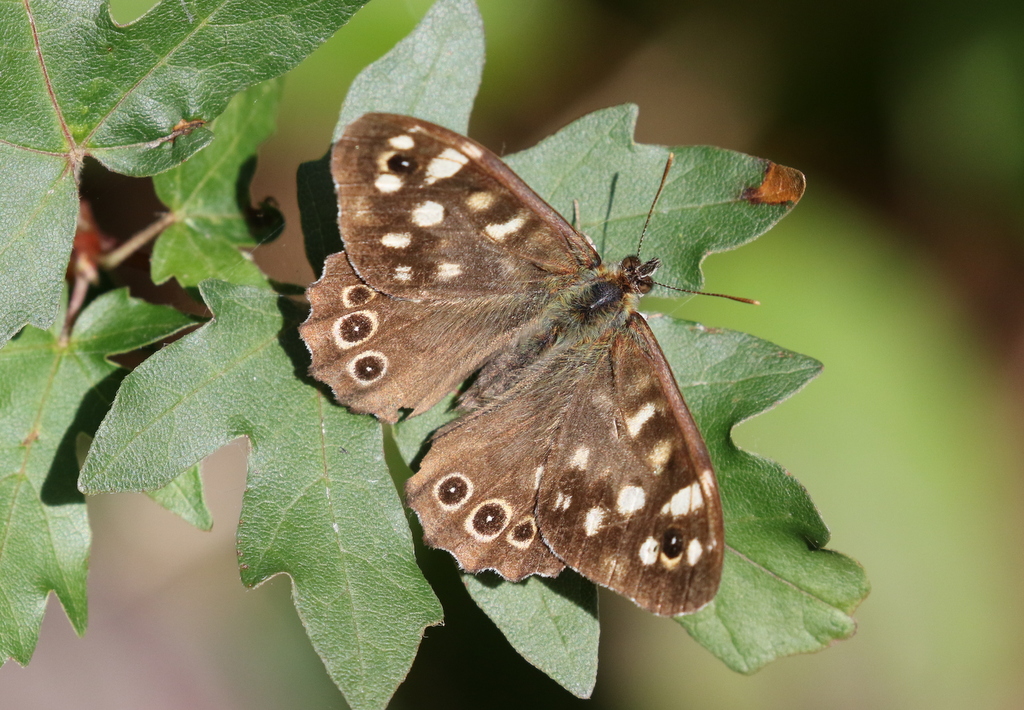
Our next destination was Cley. We arrived there still with some time before lunch, so we decided to have a walk up the East Bank first. As we walked up onto the bank from the car park, we looked back towards Snipe’s Marsh. We could see several waders over there, so we decided to walk over the road first, for a closer look.
Two Spotted Redshanks were sleeping in the cut reeds. We were looking into the sun at first, but we made our way round to where we could get a better view of them. When they woke up, we could see their long, needle fine bills. There were two Green Sandpipers feeding out on the mud too, as well as a good number of Common Snipe, appropriately enough here!

A small bird flew across and landed in the base of the reeds at the far side. Flashing white in the outer tail as it landed, we might have expected it to be a Reed Bunting here but we caught a glint of yellow as it dropped in. It was a Yellowhammer – not quite where we would expect to see one! A Reed Warbler working its way round the base of the reeds at the back was less of a surprise.
Given we were at Walsey Hills now, we had a quick walk in along the footpath through the bushes. We heard several Chiffchaffs calling, and a Coal Tit singing, but nothing else today, despite the fact the ivy here was alive with insects in the sunshine.
Over on the East Bank, it was surprisingly breezy as we walked out. We heard several Bearded Tits calling from various places in the reeds, but not surprisingly they were keeping well down today.
Looking further up, we could see a large white bird in the water at the north end of the Serpentine. It was a Spoonbill, busy feeding, so we walked up there for a closer look. We watched it sweeping its bill methodically back and forth through the shallows, occasionally throwing its head back when it caught something.
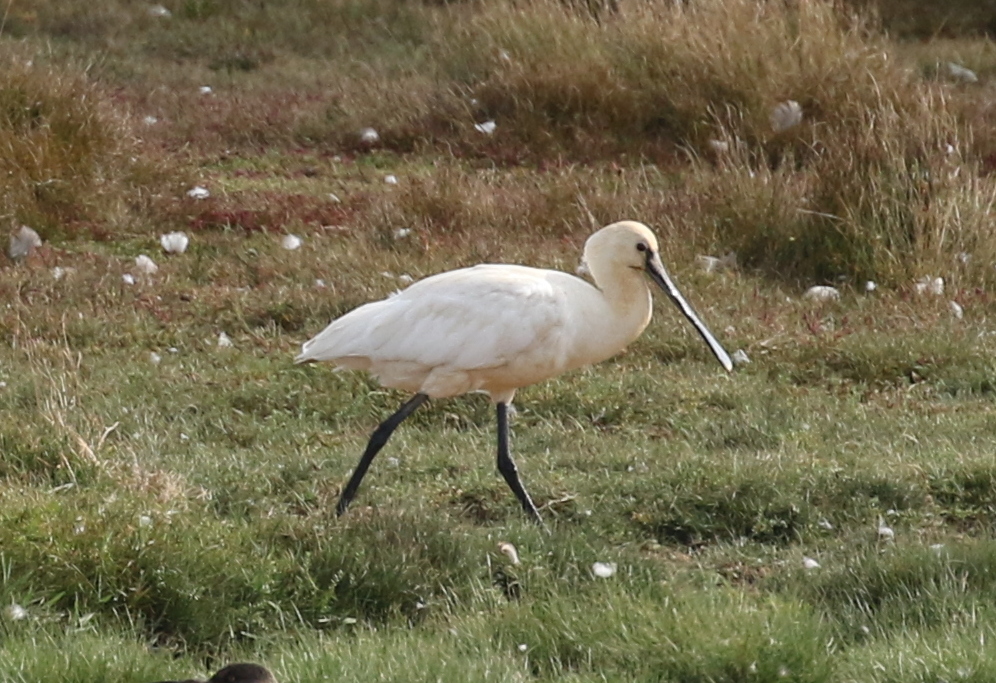
Otherwise on the Serpentine there was just a single Black-tailed Godwit, one Snipe and an Avocet, as well as a selection of commoner dabbling ducks. Pope’s Pool beyond held a few more Black-tailed Godwits and a handful of Ruff. A small group of Swallows flew through, heading determinedly west, on their way back to Africa for the winter.
There were not so many birds out on Arnold’s Marsh today, more Black-tailed Godwits, Redshanks and Curlew. We carried on out to the beach, but it was very quiet looking out to sea too, with surprisingly little moving today. So we headed back to the Visitor Centre for lunch.
After lunch, we made our way out to the hides. A quick look at Whitwell Scrape produced just a couple of Lapwing and a few ducks. We could see more birds on Simmond’s Scrape, but by the time we walked round to Dauke’s Hide, the flock of nine Dunlin we had seen drop in had flown off again. There were still two Ringed Plover on here and lots of Black-tailed Godwits busy feeding up to their bellies in the water in front of the hide.
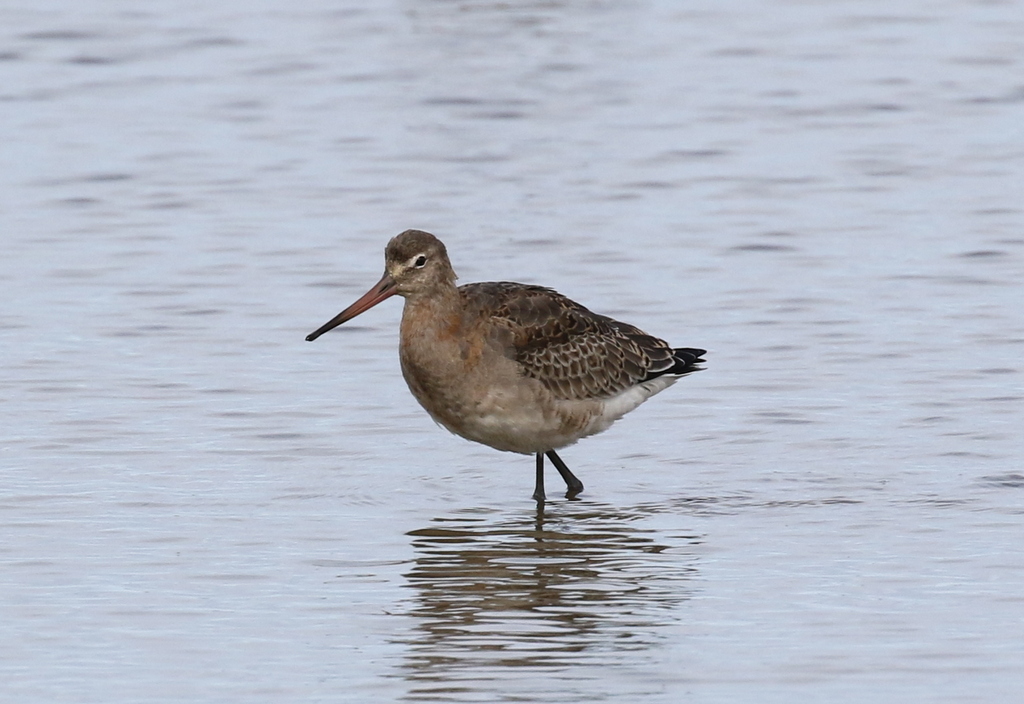
Looing across to Pat’s Pool, another Spotted Redshank was feeding on the edge of the reeds. Three Dunlin were initially towards the far side, but helpfully then flew round and landed at the front with two juvenile Ruff. Two Common Snipe were very well camouflaged out on the edge of one of the islands, hard to see until you looked through the scope.
We were planning to head out to North Scrape, as we had seen several waders landing over there, but by the time we got back to the Visitor Centre we could see one of the wardens out there on a tractor, topping the grassy edges of the scrape. A quick change of plan, and we drove back to Iron Road instead.
As we walked up along the Iron Road to look at the pools, two Spotted Redshanks flew in and landed on the area of open water just to the east. They looked to be the same two that we had seen on Snipe’s Marsh earlier. A small group of Meadow Pipits flew high overhead calling, but they could just as easily have been local birds as migrants moving.

On the other side of Iron Road, there were lots of geese out on the grazing marsh, mainly Greylags but with several pairs of Egyptian Geese too. The escaped Fulvous Whistling Duck was with them – interesting to see, but as it has come out of a cage somewhere it doesn’t count!
We walked round on the path Babcock Hide next. There was no one in the hide and we got quite a shock when we opened the window and found a cow staring back at us, just a few inches away! The cows were feeding right in front of the hide and were very inquisitive, poking their noses in through the flaps. They were not particularly helpful either, blocking the view.

We could just about see what was on the pool here though. On our way out here, we had seen a couple of flocks of Black-tailed Godwits flying in and out from the stubble field across the road, where they were feeding. There were still several loafing about out in the water. Further back, two Pintail were busy feeding, upending in amongst the Mallards. With their rear ends in the air, we could see their more pointed tails.
As we made our way back along the path, we heard a Whimbrel calling. We looked over towards the pool by Iron Road and saw it circle once before continuing on its way west, disappearing off over Walsey Hills. Surprisingly, given the time of year, this was the first migrant wader we had seen on the move today.
On our way back west, we diverted off the coast road and headed inland. We scanned the fields for partridges, but couldn’t see any today, as we made our way up to a regular site for Little Owl. It didn’t take long to find one, perched on the roof of one of the farm buildings. It was rather distant, but we had a good look at it through the scope. It was a suitably appropriate way to end the day, as we had begun, with an owl.
















